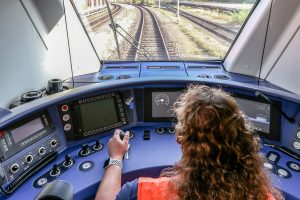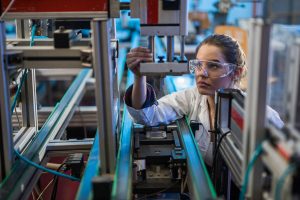 These days, there is not much that you cannot do online. Your device, be it a smartphone or a computer, allows you – with the swipe of a finger – to carry out actions as simple as ordering a pizza to significant as meeting the love of your life. These services and the sophisticated technology behind them are changing every facet of modern life – rail is no exception. While more and more passengers are beginning to see Europe’s railways as digital entities with the advent of mobile ticket purchasing and on-the-go Wi-Fi, the sector has been on the technological cutting edge since the beginning. However, harnessing emerging technologies is particularly important at this moment. As Europe and the world enter the digital age, one defined by the use of these relatively new information and communications tools, rail must swiftly develop, integrate and deploy such digital solutions to position itself as the backbone of European transport and enable its sustainable mobility future.
These days, there is not much that you cannot do online. Your device, be it a smartphone or a computer, allows you – with the swipe of a finger – to carry out actions as simple as ordering a pizza to significant as meeting the love of your life. These services and the sophisticated technology behind them are changing every facet of modern life – rail is no exception. While more and more passengers are beginning to see Europe’s railways as digital entities with the advent of mobile ticket purchasing and on-the-go Wi-Fi, the sector has been on the technological cutting edge since the beginning. However, harnessing emerging technologies is particularly important at this moment. As Europe and the world enter the digital age, one defined by the use of these relatively new information and communications tools, rail must swiftly develop, integrate and deploy such digital solutions to position itself as the backbone of European transport and enable its sustainable mobility future.
By Nicolas Furio, UNIFE Head of Technical Affairs
2020 was a year defined by crisis. Before COVID-19 proliferated across the planet and shuttered economies, it had been marked by catastrophic fires across Australia. The wildfires raged from September of the preceding year to March of 2020, causing more than EUR 1 billion in damages, devastating local ecosystems and killing 34 people. Hotter temperatures, drought and high winds – exacerbated by human-driven climate change – were blamed for the crisis. Today, after the energy sector, transport is the second largest emitter of greenhouse gases. These pollutants were a contributor to this ecological disaster and similar ones that unfolded later that year in Siberia and California.
However, it does not have to be that way. Rail, the most sustainable form of mass transport available, can serve as the backbone of Europe’s future sustainable mobility paradigm. New technologies such as 5G, Artificial Intelligence, Big Data, Digital Twins and more can make rail even more sustainable and reliable. These tools will improve basic rail activities, increase rail capacity, quicken freight operations and enable multimodal connections. UNIFE is convinced that collaborative Research & Innovative (R&I) initiatives between the rail supply industry and the EU can provide us the tools needed to decarbonise transport. Digital rail solutions are essential to achieving the EU Green Deal’s goals and the subsequent Sustainable and Smart Mobility Strategy’s vision of a European rail system that conveys twice as many passengers and freight to their destination on this mode of transport by 2030 and 2050, respectively, by 2050.
 Shift2Rail Joint Undertaking (S2R), the rail sector’s institutionalised partnership led by Executive Director Carlo Borghini, has been instrumental in improving EU and rail stakeholder cooperation on new systems that utilise the aforementioned technologies. Our cooperation has led to breakthroughs in the “ERTMS Game Changers” such as automatic train operation (ATO) and satellite positioning, the Digital Automatic Coupler (DAC), Smart Energy Metering and predictive maintenance solutions. Shift2Rail projects with UNIFE’s involvement such as IN2DREAMS, DAYDREAMS, ETALON, GATE4RAIL and SPRINT have brought together elements from all corners of the railway sector and academia and are already delivering systems needed to position rail as the backbone of European sustainable mobility. These projects are providing our sector with the Information and Communication Technologies needed to manage the growing number of digital assets across the railway network. They are also leveraging AI to make high-capacity infrastructure more cost-efficient and reliable, virtualising rail test processes and making rail safer while increasing performance.
Shift2Rail Joint Undertaking (S2R), the rail sector’s institutionalised partnership led by Executive Director Carlo Borghini, has been instrumental in improving EU and rail stakeholder cooperation on new systems that utilise the aforementioned technologies. Our cooperation has led to breakthroughs in the “ERTMS Game Changers” such as automatic train operation (ATO) and satellite positioning, the Digital Automatic Coupler (DAC), Smart Energy Metering and predictive maintenance solutions. Shift2Rail projects with UNIFE’s involvement such as IN2DREAMS, DAYDREAMS, ETALON, GATE4RAIL and SPRINT have brought together elements from all corners of the railway sector and academia and are already delivering systems needed to position rail as the backbone of European sustainable mobility. These projects are providing our sector with the Information and Communication Technologies needed to manage the growing number of digital assets across the railway network. They are also leveraging AI to make high-capacity infrastructure more cost-efficient and reliable, virtualising rail test processes and making rail safer while increasing performance.
Similar endeavours capable of creating meaningful technological advancements for the sector are also occurring outside of the S2R public-private partnership. For example, the 5GRAIL project aims to generate breakthroughs on the Future Railway Mobile Communication System (FRMCS). This project seeks to validate the first FRMCS specifications by developing and testing prototypes for both trackside infrastructure and on-board use. This new rail telecommunication system is slated to be implemented after 2025 and will support the digitalisation of Europe’s rail.
As we can see, European rail Research & Innovation projects continue to build the railways fit for a digital and carbon neutral EU. For this reason, UNIFE was satisfied to see the recent publication of the European Commission’s proposal for the Single Basic Act in late February. The proposal intends to establish 9 Joint Undertakings, including the S2R’s successor: Europe’s Rail Joint Undertaking (ERJU). As Shift2Rail approaches its terminus with Horizon 2020, this successor Joint Undertaking within the new EU R&I Framework Programme Horizon Europe will take up the mantel of coordinating the European Union’s collaboration with our sector. It will be a key player in constructing tomorrow’s European rail transport system, which will in turn serve as the backbone of a sustainable and multimodal mobility system.
 The successor programme has already begun its preparatory work and will be organised around an Innovation and a System Pillar. The Commission, with the support of S2R, has initiated two workstreams oriented around these pillars for the preparation of ERJU. The first convenes the Commission and Candidates Founding Members to prepare ERJU’s Innovation Pillar. The second – the System Pillar workstream – involves the Commission and associations representing the rail sector (including UNIFE). Working with the Commission, the rail sector will contribute to the creation of the ERJU Master Plan. This document will describe the programme’s high-level objectives and shape them to help building a fully digitalised and sustainable railway system of tomorrow which can act as the backbone of a multimodal carbon neutral transport paradigm. It will highly rely on the European Rail Research Advisory Council’s (ERRAC) Rail Strategic Research and Innovation Agenda (SRIA) and its nine Transforming Projects, which have been proposed to accelerate the digitalisation of European rail transport.
The successor programme has already begun its preparatory work and will be organised around an Innovation and a System Pillar. The Commission, with the support of S2R, has initiated two workstreams oriented around these pillars for the preparation of ERJU. The first convenes the Commission and Candidates Founding Members to prepare ERJU’s Innovation Pillar. The second – the System Pillar workstream – involves the Commission and associations representing the rail sector (including UNIFE). Working with the Commission, the rail sector will contribute to the creation of the ERJU Master Plan. This document will describe the programme’s high-level objectives and shape them to help building a fully digitalised and sustainable railway system of tomorrow which can act as the backbone of a multimodal carbon neutral transport paradigm. It will highly rely on the European Rail Research Advisory Council’s (ERRAC) Rail Strategic Research and Innovation Agenda (SRIA) and its nine Transforming Projects, which have been proposed to accelerate the digitalisation of European rail transport.
However, as Europe progresses on the necessary path towards a fully digitalised railway capable of permitting greener multimodal transportation based in rail, it is important that these digital assets remain secure. For UNIFE, the potential vulnerabilities presented by these new technologies has transformed cybersecurity into a transversal topic that must be a high priority for all EU Member States. While S2R projects, like OPTIMA and X2Rail, completed important work on the Traffic Management System and, in turn, cybersecurity, our systems need to consistently and constantly grow in sophistication at the same clip of digital innovation.
However, it is clear that the speed at which cybersecurity solutions are launched and implemented is closely linked to the amount of private and public resources allocated by the main European actors to securing our digital tools. Now more than ever, these commitments are key to assuring a fast and comprehensive deployment of new technologies and services intended to prevent or combat cyber-crime. In our Cybersecurity Vision Paper, UNIFE outlines how EU-level standardisation via CENELEC, rail sector cooperation with the European Union Agency for Railway (ERA) and the European Union Agency for Cybersecurity (ENISA) and investigating in emerging technology such as AI, Blockchain and Quantum Computing are all essential to aligning all necessary actors and anticipating threats before they result in a possible WannaCry scale attempt on critical infrastructure.
Share on:




